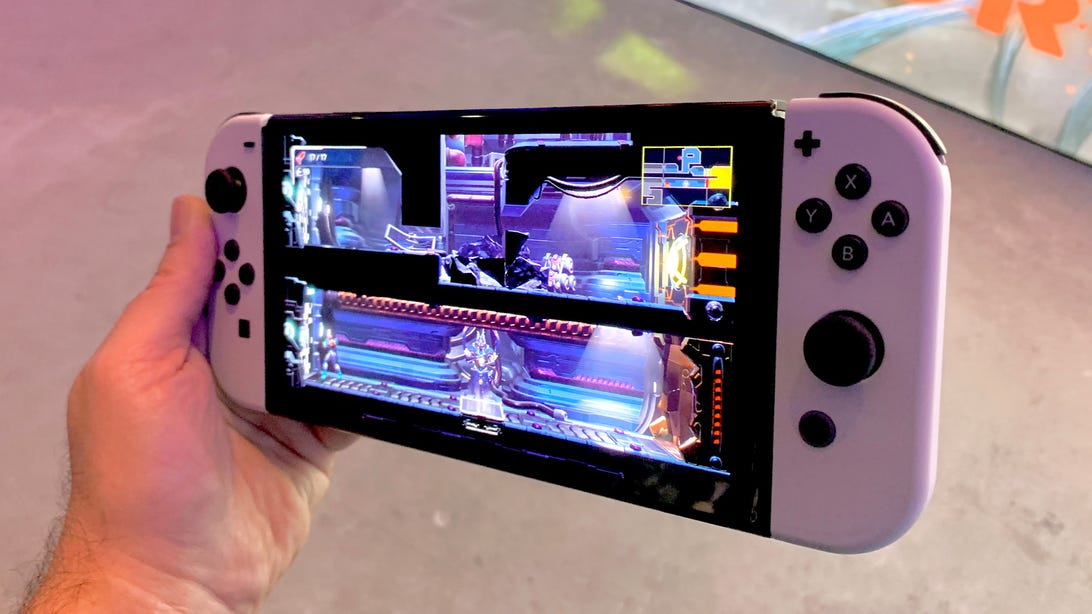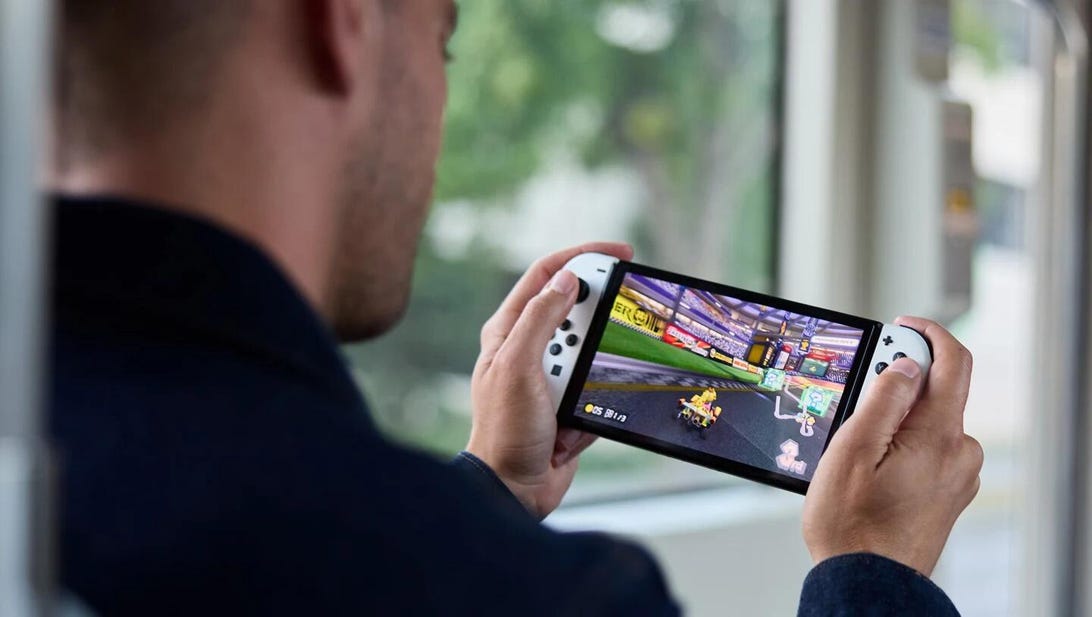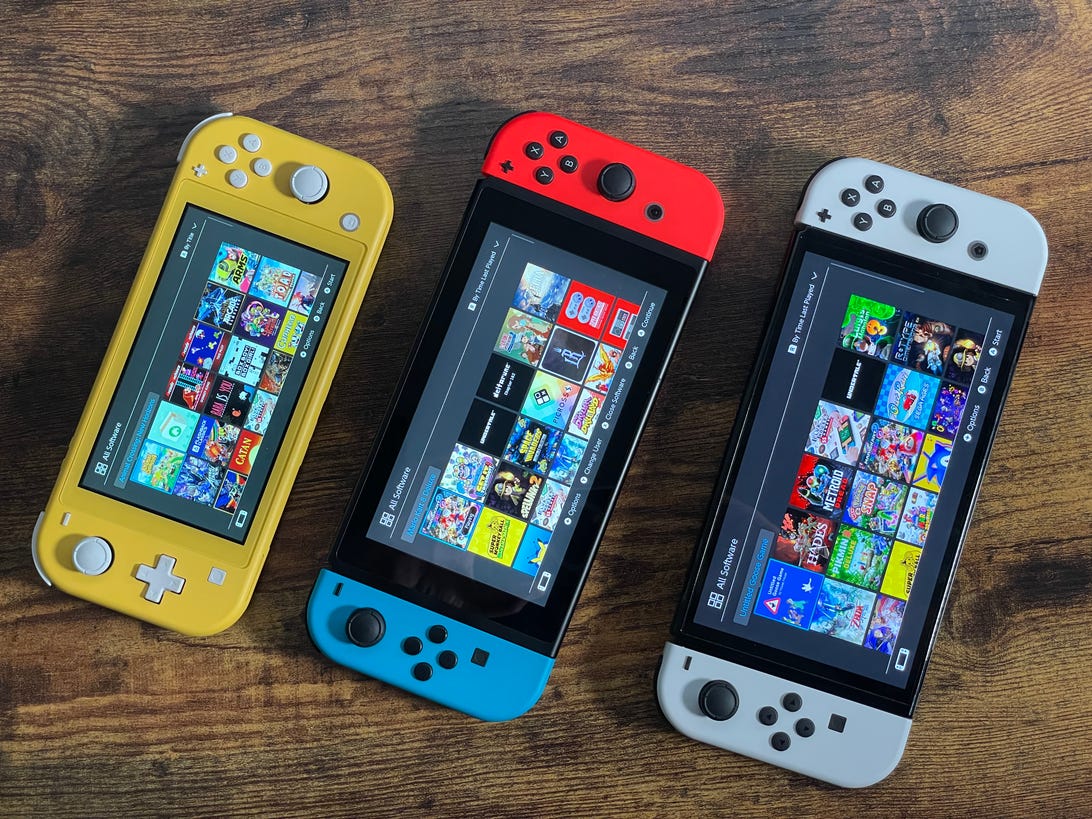

The new Switch has a bigger, better 7-inch OLED screen.
Scott Stein/CNETJust like the PlayStation 5 and the Xbox Series X, the Nintendo Switch OLED is a hot new game console that's been difficult to get your hands on. Whether you're still hunting Switch restocks or you just unboxed your own, you shouldn't be stressed about burn-in. I'm not worried about it for that shiny 7-inch OLED screen on the Nintendo Switch, and most buyers shouldn't be either.
You see, I review TVs for CNET and plenty of folks ask me about burn-in on the OLED TVs I've been recommending for years. Even though it's a lot smaller than a TV, that screen on the Nintendo Switch might ignite the same questions in your mind. But the majority of OLED TV and Switch owners don't have to stress over those pesky ghost images.
Let's start with the basics. Screens today -- on TVs, phones, laptops, tablets, smartwatches and, yes, portable game consoles -- use two major technologies: OLED (organic light emitting diode) and LCD (liquid crystal display). OLED screens have better picture quality than LCD screens, mostly because they can produce a perfect shade of black, which creates better contrast and "pop," as well as more saturated, richer color.
In his CNET review of the Switch OLED, Scott Stein said the screen was "obviously better," adding "I don't want to go back to the older Switch now. The display looks small and clearly worse, and the OLED display is already spoiling me." I haven't seen the new OLED Switch's screen in person myself yet, but in my years of owning the original Switch and countless hours of gaming on its LCD screen, I've found it mediocre at best in terms of contrast and color. I'm sure the new Switch will look a lot better.
Read more: Nintendo Switch OLED Joy-Cons may be less likely to drift
Ghost in the machine
One potential downside to OLED technology is something known as burn-in. As we put it in our extensive guide to OLED screen burn-in: "Burn-in is when a part of an image -- navigation buttons on a phone, for example, or a channel logo, news ticker or a scoreboard on a TV -- persists as a ghostly background no matter what else appears onscreen."
TV- and phone-makers who sell OLED screens, from LG to Apple to Google, acknowledge the possibility of burn-in -- aka "image persistence" or "image retention." They all characterize it as something that can happen under "extreme" or "rare" circumstances, and I agree.
Here's Nintendo's response to my request for comment about burn-in:
We've designed the OLED screen to aim for longevity as much as possible, but OLED displays can experience image retention if subjected to static visuals over a long period of time. However, users can take preventative measures to preserve the screen [by] utilizing features included in the Nintendo Switch systems by default, such as auto-brightness function to prevent the screen from getting too bright, and the auto-sleep function to go into 'auto sleep' mode after short periods of time.
In my experience reviewing (and watching) OLED TVs over the years I've never caused a case of burn-in myself, although I've never tested for it directly. One reviews site that has, rtings.com, ran a real-world TV burn-in test and came to this conclusion: "We don't expect most people who watch varied content without static areas to experience burn-in issues with an OLED TV."
As a display that will show primarily games, the OLED screen on the Nintendo Switch will definitely have some static elements, such as persistent scores in the corners, life bars, ammo counts and status icons. These could, if left onscreen for a long period of time, conceivably cause burn-in.

Static screen elements like a lap counter could cause burn-in, but probably won't be onscreen long enough to do so.
NintendoMe, worry?
Despite the persistence of static screen elements in games, there are numerous reasons I'm not worried about burn-in on the OLED Switch. Here are a few.
- Static elements like a score, life bar or reticule would have to remain onscreen for many hours at a time.
- If you play different games, they'll have different (or no) static elements, which reduces or eliminates the issue.
- Aside from games themselves, the Switch doesn't have an always-on, static menu element like the navigation bar on some phones.
- As Nintendo mentioned, the Switch has an automatic brightness feature and an automatic sleep mode that turns off the screen entirely after a set period, helping reduce the issue.
Now if I were the kind of gamer who played the same game pretty much exclusively, one that kept the same bright, persistent static elements on the portable screen constantly, I would avoid the OLED Switch. But I (like every other Switch user I know) get enough variation on the screen by playing enough different games that burn-in shouldn't be a problem.
Read more: Nintendo Switch OLED vs. all the others: Which you should buy right now?
Here's where I mention that this is all just conjecture, based on my own experience as a TV reviewer, a Switch gamer and someone who's owned a phone with an OLED screen since the Samsung Vibrant (circa 2010). The new Switch just came out, and perhaps something like the Google Pixel 2 XL burn-in issue, where the persistent bottom navigation bar caused burn-in, will surface for some OLED Switch users over the next few months. But for the reasons outlined above, I doubt it.
If that possibility worries you, however, then by all means don't buy the new Switch. Or just get a Switch with a traditional LCD screen.

The Switch Lite (left) and original Switch (middle) have LCD screens, while the OLED Switch (right) has -- yup -- an OLED screen
Scott Stein/CNETFor my part, I consider the risk of burn-in to be entirely worth the benefit of OLED. In fact, compared with a TV that can be left on for hours or days at a time playing one channel with a persistent logo like CNN, I expect reports of burn-in to be less common with the Switch than with TVs.
I have plenty of other questions about the new Switch, for example how the OLED screen affects battery life, how it performs outdoors or in other bright light and whether it crushes shadow detail or makes colors look less realistic. Whether burn-in will be a problem isn't one of them.









 Add Category
Add Category